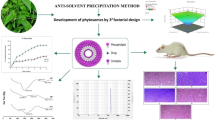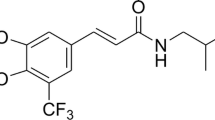Abstract
Purpose
In this study, the herbal formulation containing nanophytosomes of Mucuna prureins extract (MPE) was engineered to ameliorate its rate of drug release, in vivo antidepressant profile, and stability.
Method
The Mucuna prureins nanophytosomes (MPP) were designed by using a full factorial design approach, taking into consideration various variables that could give optimized formulation. Then, pure extract and optimized formulation showing higher entrapment efficiency were studied for in vitro dissolution and in vivo antidepressant activity in depression models like forced swimming test (FST) and tail suspension test (TST) in Swiss albino mice. The physicochemical characterization was carried out using particle size analysis and zeta potential, Fourier transformation infrared spectroscopy, differential scanning calorimetry, proton nuclear magnetic resonance, powder X-ray diffractometer, scanning electron microscopy, and solubility studies. Moreover, the stability of nanophytosomes was assessed by subjecting optimized formulation to freeze–thaw cycle stability testing and calculating entrapment efficiency at the end of the cycle.
Results
PXRD and SEM revealed a decrease in the crystalline nature of nanophytosomes. 1H NMR, DSC, and FTIR asserted the formation of the phyto-phospholipids complex. The rate and extent of dissolution were also found enhanced and sustained in nanophytosomes as compared to pure extract. In vivo antidepressant activity depicted a significant reduction of immobility in mice treated with nanophytosomes as compared to those treated with the pure extract. Moreover, optimized formulation was found stable as entrapment efficiency values were not reduced significantly.
Conclusion
Thus, nanophytosomes drug delivery could be the best strategy to improve physicochemical properties of extract and thus could be exploited for the extracts having poor solubility, poor permeability, and poor stability.
Graphical Abstract












Similar content being viewed by others
References
Ravikumar P, Jeyam M. Antidepressant activity and HPTLC fingerprinting of stearic acid in different days of wheat seedlings. Grain & Oil Science and Technology. 2019;2(1):6–10.
Nestler EJ, Barrot M, DiLeone RJ, Eisch AJ, Gold SJ, Monteggia LM. Neurobiology of depression. Neuron. 2002;34(1):13–25.
Gillespie CF, Nemeroff CB. Hypercortisolemia and depression. Psychosom Med. 2005;67:S26–8.
Dereli FTG, Ilhan M, Sobarzo-Sánchez E, Akkol EK. The investigation of the potential antidepressant-like activity of Xanthium orientale subsp. italicum (Moretti) Greuter in rodents. J Ethnopharmacol. 2020;258:112914.
Yemez B, Alptekin K. Depression etiology. World of Psychiatry. 1998;2(1):21–5.
Singh GK, Garabadu D, Muruganandam A, Joshi VK, Krishnamurthy S. Antidepressant activity of Asparagus racemosus in rodent models. Pharmacol Biochem Behav. 2009;91(3):283–90.
Huprich SK. What should become of depressive personality disorder in DSM-V? Harv Rev Psychiatry. 2009;17(1):41–59.
Schmidt HD, Shelton RC, Duman RS. Functional biomarkers of depression: diagnosis, treatment, and pathophysiology. Neuropsychopharmacology. 2011;36(12):2375–94.
Gold PW, Goodwin FK, Chrousos GP. Clinical and biochemical manifestations of depression. N Engl J Med. 1988;319(7):413–20.
Randrup A. Mania, depression, and brain dopamine. 1975.
Muscat R, Papp M, Willner P. Antidepressant-like effects of dopamine agonists in an animal model of depression. Biol Psychiat. 1992;31(9):937–46.
Rana DG, Galani VJ. Dopamine mediated antidepressant effect of Mucuna pruriens seeds in various experimental models of depression. Ayu. 2014;35(1):90.
Bet PM, Hugtenburg JG, Penninx BW, Hoogendijk WJ. Side effects of antidepressants during long-term use in a naturalistic setting. Eur Neuropsychopharmacol. 2013;23(11):1443–51.
Zhang Z-J. Therapeutic effects of herbal extracts and constituents in animal models of psychiatric disorders. Life Sci. 2004;75(14):1659–99.
Lampariello LR, Cortelazzo A, Guerranti R, Sticozzi C, Valacchi G. The magic velvet bean of Mucuna pruriens. J Tradit Complement Med. 2012;2(4):331–9.
Nweze NE, Ezema C, Ezema AS, Eze JI, Ezema WS. Toxicity and nutritional studies on Mucuna pruriens leaves from Nsukka, South-Eastern Nigeria. Comp Clin Pathol. 2017;26(3):569.
Amin KY, Khan M, Zillur-Rehman S, Khan N. Sexual function improving effect of Mucuna pruriens in sexually normal male rats. Fitoterapia (Milano). 1996;67(1):53–8.
Gupta M, Chakrabarti S, Bhattacharya S, Rath N. Anti-epileptic and anti-cancer activity of some indigenous plants. Indian J Physiol Allied Sciences. 1997;51:53–6.
Sathiyanarayanan L, Arulmozhi S. Mucuna pruriens Linn.-A comprehensive review. Pharmacogn Rev. 2007;1(1).
Rajeshwar Y, Kumar GS, Gupta M, Mazumder UK. Studies on in vitro antioxidant activities of methanol extract of Mucuna pruriens (Fabaceae) seeds. Eur Bull Drug Res. 2005;13(1):31–9.
Jalalpure S, Alagawadi K, Mahajanashetti C, Shah B, Singh V, Patil J. In vitro anthelmintic property of various seed oils against Pheritima posthuma. Indian J Pharm Sci. 2007;69(1):158.
Guerranti R, Aguiyi JC, Errico E, Pagani R, Marinello E. Effects of Mucuna pruriens extract on activation of prothrombin by Echis carinatus venom. J Ethnopharmacol. 2001;75(2–3):175–80.
Misra L, Wagner H. Alkaloidal constituents of Mucuna pruriens seeds. Phytochemistry. 2004;65(18):2565–7.
Hishika R, Shastry S, Shinde S, Guptal S. Preliminary phytochemical and anti-inflammatory activity of seeds of Mucuna pruriens. Indian J pharmacol. 1981;13(1):97–8.
Siddhuraju P, Becker K. Rapid reversed-phase high performance liquid chromatographic method for the quantification of L-Dopa (L-3, 4-dihydroxyphenylalanine), non-methylated and methylated tetrahydroisoquinoline compounds from Mucuna beans. Food Chem. 2001;72(3):389–94.
Tripathi YB, Upadhyay AK. Antioxidant property of Mucuna pruriens Linn. Curr Sci. 2001;80(11):1377–8.
Kemp K, Griffiths J, Campbell S, Lovell K. An exploration of the follow-up up needs of patients with inflammatory bowel disease. J Crohns Colitis. 2013;7(9):e386–95.
Minaei A, Sabzichi M, Ramezani F, Hamishehkar H, Samadi N. Co-delivery with nano-quercetin enhances doxorubicin-mediated cytotoxicity against MCF-7 cells. Mol Biol Rep. 2016;43(2):99–105.
Singh RP, Narke R. Preparation and evaluation of phytosome of lawsone. Int J Pharm Sci Res. 2015;6(12):5217.
Mattos BD, Tardy BL, Magalhães WL, Rojas OJ. Controlled release for crop and wood protection: Recent progress toward sustainable and safe nanostructured biocidal systems. J Control Release. 2017;262:139–50.
Maiti K, Mukherjee K, Gantait A, Saha BP, Mukherjee PK. Curcumin–phospholipid complex: preparation, therapeutic evaluation and pharmacokinetic study in rats. Int J Pharm. 2007;330(1–2):155–63.
Maryana W, Rachmawati H, Mudhakir D. Formation of phytosome containing silymarin using thin layer-hydration technique aimed for oral delivery. Materials today: proceedings. 2016;3(3):855–66.
Saoji SD, Raut NA, Dhore PW, Borkar CD, Popielarczyk M, Dave VS. Preparation and evaluation of phospholipid-based complex of standardized centella extract (SCE) for the enhanced delivery of phytoconstituents. AAPS J. 2016;18(1):102–14.
Maiti K, Mukherjee K, Murugan V, Saha BP, Mukherjee PK. Exploring the effect of hesperetin–HSPC complex—a novel drug delivery system on the in vitro release, therapeutic efficacy and pharmacokinetics. AAPS PharmSciTech. 2009;10(3):943–50.
Porsolt RD, Le Pichon M, Jalfre M. Depression: a new animal model sensitive to antidepressant treatments. Nature. 1977;266(5604):730–2.
Elsheikh MA, Elnaggar YS, Gohar EY, Abdallah OY. Nanoemulsion liquid preconcentrates for raloxifene hydrochloride: optimization and in vivo appraisal. Int J Nanomed. 2012;7:3787.
Yi H, Yang Z, Yongfang Z. The purification and the identification of lecithin and its application. Amino Acids and Biotic Resources. 2001;23(2):28–31.
Shivanand P, Kinjal P. Phytosomes: technical revolution in phytomedicine. Int J Pharmtech Res. 2010;2(1):627–31.
Yanyu X, Yunmei S, Zhipeng C, Qineng P. The preparation of silybin–phospholipid complex and the study on its pharmacokinetics in rats. Int J Pharm. 2006;307(1):77–82.
Lasonder E, Weringa WD. An NMR and DSC study of the interaction of phospholipid vesicles with some anti-inflammatory agents. J Colloid Interface Sci. 1990;139(2):469–78.
Perrut M, Jung J, Leboeuf F. Enhancement of dissolution rate of poorly-soluble active ingredients by supercritical fluid processes: Part I: Micronization of neat particles. Int J Pharm. 2005;288(1):3–10.
Kumari R, Agrawal A, Ilango K, Singh G, Dubey G. In vivo evaluation of the antidepressant activity of a novel polyherbal formulation. Autism-Open Access. 2016;6(194):2.
Kavitha K. Evaluation of total phenols, total flavonoids, antioxidant, and anticancer activity of Mucuna pruriens seed extract. Asian J Pharm Clin Res. 2018;11(3):242–6.
Jabbari M, Gharib F. Solvent dependence on antioxidant activity of some water-insoluble flavonoids and their cerium (IV) complexes. J Mol Liq. 2012;168:36–41.
Nagajyothi P, Sreekanth T, Lee J-i, Lee KD. Mycosynthesis: antibacterial, antioxidant and antiproliferative activities of silver nanoparticles synthesized from Inonotus obliquus (Chaga mushroom) extract. J Photochem Photobiol B. 2014;130:299–304.
Telange DR, Patil AT, Pethe AM, Fegade H, Anand S, Dave VS. Formulation and characterization of an apigenin-phospholipid phytosome (APLC) for improved solubility, in vivo bioavailability, and antioxidant potential. Eur J Pharm Sci. 2017;108:36–49.
LeFevre M, Olivo R, Vanderhoff J, Joel D. Accumulation of latex in Peyer’s patches and its subsequent appearance in villi and mesenteric lymph nodes. Proc Soc Exp Biol Med. 1978;159(2):298–302.
Savić R, Luo L, Eisenberg A, Maysinger D. Micellar nanocontainers distribute to defined cytoplasmic organelles. Science. 2003;300(5619):615–8.
Hou Z, Li Y, Huang Y, Zhou C, Lin J, Wang Y, et al. Phytosomes loaded with mitomycin C–soybean phosphatidylcholine complex developed for drug delivery. Mol Pharm. 2013;10(1):90–101.
Yu F, Li Y, Chen Q, He Y, Wang H, Yang L, et al. Monodisperse microparticles loaded with the self-assembled berberine-phospholipid complex-based phytosomes for improving oral bioavailability and enhancing hypoglycemic efficiency. Eur J Pharm Biopharm. 2016;103:136–48.
Venema FR, Weringa WD. The interactions of phospholipid vesicles with some anti-inflammatory agents. J Colloid Interface Sci. 1988;125(2):484–92.
Cai X, Luan Y, Jiang Y, Song A, Shao W, Li Z, et al. Huperzine A–phospholipid complex-loaded biodegradable thermosensitive polymer gel for controlled drug release. Int J Pharm. 2012;433(1–2):102–11.
Jena SK, Singh C, Dora CP, Suresh S. Development of tamoxifen-phospholipid complex: novel approach for improving solubility and bioavailability. Int J Pharm. 2014;473(1–2):1–9.
Jayanthi P, Lalitha P. Determination of the in vitro reducing power of the aqueous extract of Eichhornia crassipes (Mart.) Solms. J Pharm Res. 2011;4:4003–5.
Dash S, Murthy PN, Nath L, Chowdhury P. Kinetic modeling on drug release from controlled drug delivery systems. Acta Pol Pharm. 2010;67(3):217–23.
Willner P. The validity of animal models of depression. Psychopharmacology. 1984;83(1):1–16.
Thierry B, Steru L, Simon P, Porsolt R. The tail suspension test: ethical considerations. Psychopharmacology. 1986;90(2):284–5.
Gershon AA, Vishne T, Grunhaus L. Dopamine D2-like receptors and the antidepressant response. Biol Psychiat. 2007;61(2):145–53.
Monleon S, Parra A, Simon V, Brain P, D’Aquila P, Willner P. Attenuation of sucrose consumption in mice by chronic mild stress and its restoration by imipramine. Psychopharmacology. 1995;117(4):453–7.
Yalcin I, Aksu F, Belzung C. Effects of desipramine and tramadol in a chronic mild stress model in mice are altered by yohimbine but not by pindolol. Eur J Pharmacol. 2005;514(2–3):165–74.
Dhir A, Kulkarni S. Involvement of dopamine (DA)/serotonin (5-HT)/sigma (σ) receptor modulation in mediating the antidepressant action of ropinirole hydrochloride, a D2/D3 dopamine receptor agonist. Brain Res Bull. 2007;74(1–3):58–65.
Lu M, Qiu Q, Luo X, Liu X, Sun J, Wang C, et al. Phyto-phospholipid complexes (phytosomes): A novel strategy to improve the bioavailability of active constituents. Asian J Pharm Sci. 2019;14(3):265–74.
Awasthi R, Kulkarni G, Pawar VK. Phytosomes: an approach to increase the bioavailability of plant extracts. Int J Pharm Pharm Sci. 2011;3(2):1–3.
Acknowledgements
The authors are thankful to Alkem Laboratories Pvt. Ltd., Mumbai, India, for providing the drug levodopa. The authors are also thankful to Amsar Goa Pvt. Ltd, Goa, India, for providing Mucuna prureins extract and VAV Pvt. Ltd, Mumbai, India, for providing Soya Phosphatidylcholine (SPC; LECIVA S-70) as gift samples. The authors also extend thanks to Shivaji University, Kolhapur, and Savitribhai Phule University, Pune, India, to perform characterization studies. The authors also extend gratitude to Crystal Biology Solutions, Pune, India, for performing in vivo antidepressant activity. The laboratory facilities provided by Principal, Bharati Vidyapeeth College of Pharmacy, Kolhapur, India, and Principal, Indira College of Pharmacy, Pune, India, are also acknowledged gratefully.
Funding
This research did not receive any specific grant from funding agencies in the public, commercial, or not-for-profit sectors.
Author information
Authors and Affiliations
Corresponding author
Ethics declarations
Conflict of Interest
All authors declare that there is no conflict of interest.
Additional information
Publisher's Note
Springer Nature remains neutral with regard to jurisdictional claims in published maps and institutional affiliations.
Rights and permissions
About this article
Cite this article
Karekar, P., Killedar, S., Kulkarni, S. et al. Design and Optimization of Nanophytosomes Containing Mucuna prureins Hydroalcoholic Extract for Enhancement of Antidepressant Activity. J Pharm Innov 18, 310–324 (2023). https://doi.org/10.1007/s12247-022-09646-w
Accepted:
Published:
Issue Date:
DOI: https://doi.org/10.1007/s12247-022-09646-w




